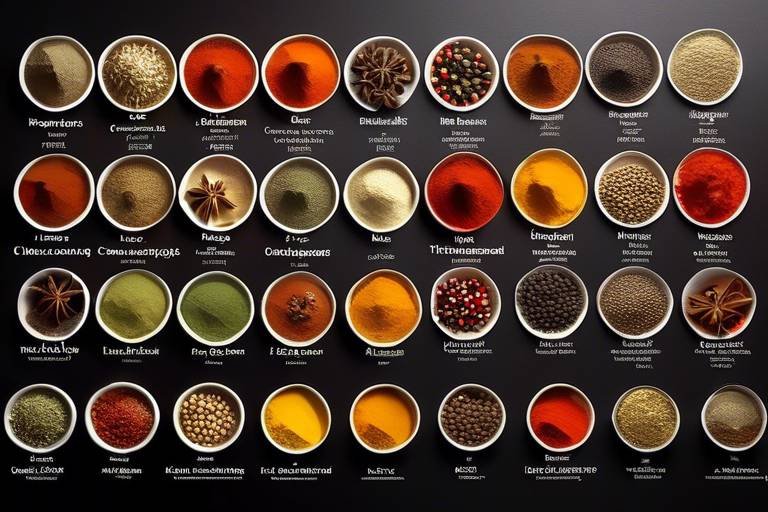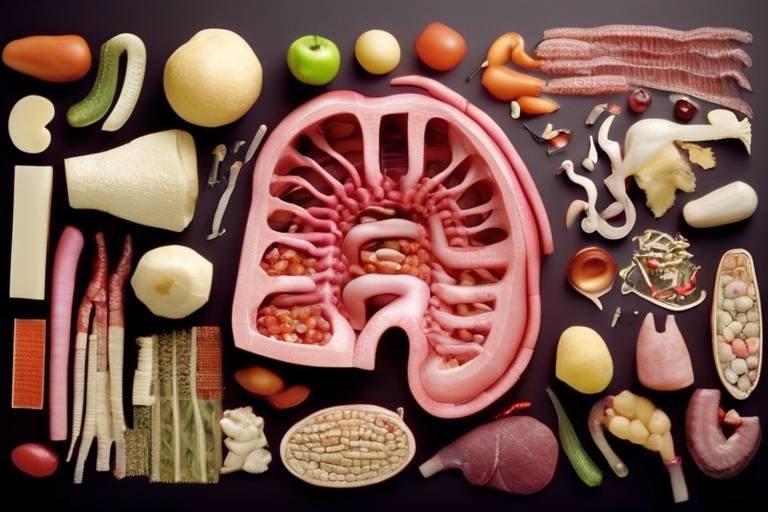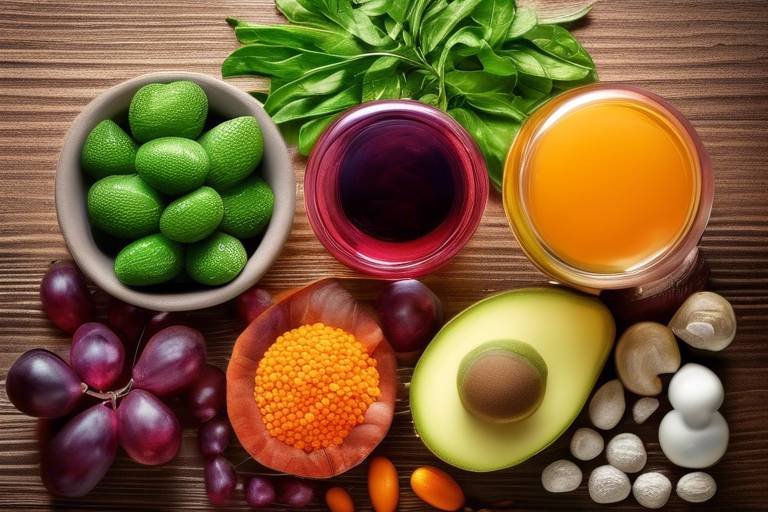The Chemistry of Spices - How They Enhance Flavor
Have you ever wondered why a dash of cinnamon can transform a mundane dish into something extraordinary? The secret lies in the chemistry of spices. Spices are not just mere flavor enhancers; they are a complex concoction of chemical compounds that interact with our taste buds in fascinating ways. When we cook, these compounds release their unique flavors and aromas, creating a symphony of taste that can elevate any meal from ordinary to unforgettable.
At the heart of this flavor explosion are volatile compounds. These are the aromatic molecules that give spices their distinctive scents and tastes. For instance, the spicy kick of black pepper comes from a compound called piperine, while the sweet undertones of vanilla are due to vanillin. When we sprinkle these spices into our dishes, we’re not just adding color or aroma; we’re incorporating a complex chemistry that engages our senses and enhances our overall culinary experience.
But it’s not just about taste. The chemistry of spices also plays a crucial role in how they interact with other ingredients. For example, some spices can enhance the sweetness of a dish, while others might add a savory depth. This interplay is what makes cooking so rewarding and creative. Think of it like a dance, where each spice has its own rhythm and contributes to a larger performance. When you master this chemistry, you become not just a cook, but an artist in the kitchen.
Moreover, the way spices are prepared can significantly impact their flavor. Grinding, toasting, or infusing spices can release different compounds, altering the taste profile of your dish. Imagine the difference between using whole cumin seeds versus ground cumin; the latter releases more oils and flavors, making your curry sing with vibrancy. Understanding these nuances can be the key to unlocking the full potential of your culinary creations.
In essence, the chemistry of spices is a delightful exploration of taste, aroma, and health benefits. By grasping how these compounds work, we can not only enhance our cooking but also appreciate the rich history and culture that each spice brings to the table. So, the next time you reach for that jar of paprika or sprinkle some oregano into your sauce, remember: you’re not just cooking; you’re engaging in a beautiful dance of chemistry that has been perfected over centuries.
- What are the main flavor compounds in spices? Different spices contain various flavor compounds, such as piperine in black pepper and curcumin in turmeric, each contributing unique tastes.
- How do essential oils enhance the flavor of spices? Essential oils contain concentrated flavor compounds that can intensify the taste and aroma of dishes when used in cooking.
- What are the health benefits of using spices? Many spices have antioxidant and anti-inflammatory properties, promoting overall health and well-being.
- Can spices improve digestion? Yes, certain spices like ginger and cumin can aid digestion and support gut health.

Understanding Flavor Compounds
When you bite into a dish bursting with flavor, have you ever wondered what makes it so tantalizing? The secret often lies in the flavor compounds found in spices. These compounds are like the unique fingerprints of each spice, responsible for their distinct tastes and aromas. Imagine walking into a kitchen filled with the warm, inviting scent of cinnamon or the zesty aroma of freshly grated ginger. What you’re experiencing are the volatile compounds that interact with your olfactory senses, creating a symphony of flavors that dance on your palate.
Flavor compounds can be categorized into several groups, each contributing to the overall profile of a spice. For instance, terpenes are responsible for the citrusy notes found in spices like coriander and lemon zest, while phenols give cloves and allspice their warm, spicy characteristics. These compounds interact not only with our taste buds but also with our sense of smell, making the experience of eating a multi-sensory delight.
But how do these compounds work their magic? When we consume spices, the flavor compounds dissolve in our saliva and interact with taste receptors on our tongues. This reaction sends signals to our brain, which interprets them as specific tastes—sweet, sour, salty, bitter, and umami. Interestingly, the combination of different spices can create complex flavor profiles that elevate a simple dish into a culinary masterpiece. Think of how a pinch of cumin can transform a bland soup into a hearty, flavorful meal. This is the science of flavor at work!
To give you an idea of how diverse flavor compounds can be, here’s a quick look at some common spices and their primary flavor compounds:
| Spice | Flavor Compounds | Characteristics |
|---|---|---|
| Cinnamon | Cinnamaldehyde | Sweet, warm, and slightly spicy |
| Black Pepper | Piperine | Spicy, pungent, and earthy |
| Ginger | Gingerol | Spicy, zesty, and aromatic |
| Cilantro | Allyl isothiocyanate | Fresh, citrusy, and slightly peppery |
Understanding flavor compounds is not just for chefs or food scientists; it’s for anyone who loves to cook or eat. By recognizing how these compounds interact with one another and with our taste buds, we can become more intentional in our cooking. Want to add depth to your next dish? Consider the flavor compounds at play and how they can complement or contrast with one another. It’s like being a conductor of a flavor orchestra, where each spice plays its part to create a delicious harmony.
So, the next time you sprinkle a dash of spice into your meal, remember that you’re not just adding flavor; you’re engaging in a fascinating dance of chemistry that enhances your culinary experience. The world of flavor compounds is vast and intricate, but with a little curiosity and experimentation, anyone can become a flavor aficionado!

The Role of Essential Oils
This article explores the fascinating chemistry behind spices, revealing how their compounds interact with our taste buds and elevate culinary experiences. Discover the science that makes spices essential in cooking.
Flavor compounds in spices are responsible for their unique tastes and aromas. This section delves into the chemical structures that contribute to flavor profiles and how they interact with food.
Essential oils extracted from spices are like the secret weapons in a chef's arsenal, packed with concentrated flavor compounds that can dramatically transform a dish. These oils not only enhance the taste but also contribute to the aroma, creating a multi-sensory experience that tantalizes the palate. Imagine biting into a dish where the aroma of fresh basil or the zing of ginger makes your taste buds dance; that’s the magic of essential oils at work!
When it comes to cooking, the potency of essential oils means that a little goes a long way. Just a few drops can elevate a simple meal into a gourmet experience. For instance, adding a hint of clove oil to a pumpkin pie can intensify its flavor profile, making it richer and more aromatic. But how do these oils work their magic? Essentially, they interact with our taste receptors, enhancing flavors and sometimes even introducing new ones. This interaction is why certain spices can completely change the character of a dish.
Moreover, the extraction of these essential oils is an art in itself. Different methods yield oils with varying qualities, and understanding these techniques can help both chefs and home cooks choose the right oil for their culinary needs. For example, steam distillation is widely used for extracting oils from spices like cinnamon and cardamom, ensuring that the delicate flavor compounds are preserved. On the other hand, cold pressing is primarily used for citrus oils, capturing the essence of the peel without the heat that could alter the flavor.
In the culinary world, essential oils are used in various applications, from flavoring beverages to enhancing marinades and sauces. Chefs often experiment with these oils to create unique flavor profiles that surprise and delight diners. The versatility of essential oils makes them an essential component in modern cooking, allowing for creativity and innovation in the kitchen.
Different extraction techniques, such as steam distillation and cold pressing, yield various qualities of essential oils. This subsection discusses the pros and cons of each method in capturing spice flavors.
Steam distillation is a common method for extracting essential oils. This part highlights its effectiveness in preserving the integrity of volatile compounds found in spices.
Cold pressing is another technique used primarily for citrus peels. This section outlines how it works and its impact on flavor retention compared to steam distillation.
Essential oils and flavor compounds are widely used in cooking. This section explores how chefs utilize these elements to enhance dishes and create unique flavor profiles.
Beyond flavor, spices offer numerous health benefits. This section discusses the medicinal properties of various spices and their role in promoting overall well-being.
Many spices contain antioxidants that help combat free radicals. Here, we explore specific spices known for their high antioxidant content and their health implications.
Certain spices possess anti-inflammatory properties that can benefit health. This subsection details how these spices work in the body and their potential therapeutic uses.
- What are essential oils? Essential oils are concentrated extracts from plants that capture their natural scent and flavor.
- How are essential oils used in cooking? They can be added to dishes to enhance flavor, used in marinades, or even in beverages.
- Are there health benefits to using spices? Yes, many spices have antioxidant and anti-inflammatory properties that can contribute to overall health.
- Can essential oils be harmful? While beneficial in small amounts, essential oils should be used cautiously and diluted as needed.

Extraction Techniques
When it comes to extracting the vibrant flavors of spices, the methods employed can significantly influence the quality and potency of the essential oils produced. Two of the most popular techniques are steam distillation and cold pressing. Each method has its own unique advantages and disadvantages, and understanding these can help you appreciate the complexities behind your favorite spices.
Steam distillation is often regarded as the gold standard for extracting essential oils. This technique involves passing steam through plant material, which causes the essential oils to evaporate. The steam and oil vapor are then cooled, condensing back into liquid form, allowing the oils to be separated from the water. One of the key benefits of steam distillation is its ability to preserve the integrity of volatile compounds, which are crucial for maintaining the spice's authentic flavor profile. This method is particularly effective for spices such as peppermint, cinnamon, and clove, where the delicate balance of flavor compounds can easily be lost with improper extraction.
On the other hand, cold pressing is primarily used for citrus peels, such as oranges and lemons. This method involves mechanically pressing the peels to release their oils without the use of heat. While cold pressing is effective in capturing the fresh, zesty flavors of citrus, it may not be suitable for all spices. The lack of heat can help retain certain volatile compounds, but it may also limit the extraction of deeper, more complex flavors found in spices like ginger or cardamom. Understanding these nuances can help chefs and home cooks alike choose the right spice for their culinary creations.
To summarize the differences between these extraction techniques, consider the following table:
| Technique | Best For | Advantages | Disadvantages |
|---|---|---|---|
| Steam Distillation | Most spices (e.g., peppermint, cinnamon) | Preserves volatile compounds, effective for complex flavors | Requires specialized equipment, can be costly |
| Cold Pressing | Citrus peels (e.g., lemon, orange) | Retains fresh flavors, simple process | Limited to citrus, may not capture complex spice flavors |
In conclusion, the choice of extraction technique plays a pivotal role in determining the flavor and quality of essential oils derived from spices. Whether through the careful process of steam distillation or the straightforward method of cold pressing, each technique offers unique benefits that can elevate your culinary experiences. Understanding these methods not only enhances your appreciation for spices but also allows you to make informed choices in your cooking adventures.

Steam Distillation
Steam distillation is a fascinating and widely used method for extracting essential oils from spices, herbs, and other aromatic plants. This technique takes advantage of the unique properties of steam to separate the volatile compounds responsible for the distinct flavors and fragrances found in various spices. Essentially, steam is passed through the plant material, causing the essential oils to evaporate. The steam and oil vapor are then cooled, allowing the oil to condense and separate from the water. This method is particularly effective because it preserves the delicate balance of flavor compounds, ensuring that the final product retains the rich essence of the original spice.
One of the key benefits of steam distillation is its ability to extract oils without exposing them to high temperatures that could potentially degrade their quality. The process operates at lower temperatures, which helps maintain the integrity of the volatile compounds. This is crucial for spices like cardamom, clove, and cinnamon, where the subtle nuances of flavor can easily be lost through excessive heat. Moreover, steam distillation is not only efficient but also environmentally friendly, as it typically requires minimal use of solvents.
To understand the effectiveness of steam distillation, let’s take a closer look at the process:
| Step | Description |
|---|---|
| 1. Preparation | The spice material is prepared by chopping or grinding to increase surface area. |
| 2. Steam Generation | Steam is generated in a boiler and directed into the distillation chamber containing the spice. |
| 3. Vaporization | The steam passes through the spice, vaporizing the essential oils. |
| 4. Condensation | The vapor mixture is cooled in a condenser, where the steam condenses back into water. |
| 5. Separation | The essential oil separates from the water and is collected. |
Despite its many advantages, steam distillation is not without its challenges. The quality of the essential oil can vary based on several factors, including the type of spice, the conditions under which it is grown, and the specifics of the distillation process itself. For instance, the duration of steam exposure and the pressure applied can significantly affect the yield and quality of the essential oil extracted. Therefore, skilled practitioners must carefully monitor these variables to ensure the highest quality output.
In summary, steam distillation is a crucial technique in the world of spice extraction, allowing us to capture the essence of spices in their purest form. By understanding this process, we can appreciate not only the complexity of flavors in our culinary experiences but also the intricate science behind the spices that enhance our dishes.
- What types of spices can be extracted using steam distillation?
Many spices can be extracted, including cinnamon, clove, and cardamom, among others.
- Is steam distillation safe?
Yes, steam distillation is considered a safe method for extracting essential oils, as it does not involve harmful solvents.
- How does steam distillation compare to other extraction methods?
Steam distillation is often preferred because it preserves the delicate flavor compounds better than methods that use high heat or solvents.

Cold Pressing
Cold pressing is a fascinating extraction technique primarily used for obtaining essential oils from citrus peels, such as oranges, lemons, and limes. Unlike steam distillation, which applies heat, cold pressing relies on mechanical pressure to extract oils without altering their delicate chemical structure. This method is particularly revered for preserving the freshness and vibrant flavors of the fruit, resulting in essential oils that are bursting with aromatic goodness.
The process begins with the selection of ripe fruits, which are then washed to remove any contaminants. Once prepped, the fruits are mechanically pressed, and the oils are released along with the juice. This method allows for a more natural extraction of flavors, as it avoids the degradation of sensitive compounds that can occur with heat. The result is a highly concentrated oil that retains the true essence of the fruit, making it a favorite among chefs and food enthusiasts alike.
One of the standout benefits of cold-pressed oils is their rich flavor profile. Since no heat is involved, the oils maintain their natural aroma and taste, making them ideal for culinary applications. For instance, a few drops of cold-pressed lemon oil can elevate a dish, adding a zesty brightness that is hard to replicate with other methods. Additionally, the oils extracted through cold pressing are often more potent, meaning that a smaller quantity can achieve the desired flavor intensity.
However, cold pressing does have its limitations. The yield of essential oils is generally lower compared to steam distillation, which means that more raw material is required to produce the same amount of oil. This can make cold-pressed oils more expensive, but many chefs argue that the flavor payoff is worth the investment. Moreover, since the process is less efficient, it may not be the best choice for all spices or herbs, particularly those that do not yield well under pressure.
In summary, cold pressing is an invaluable technique in the culinary world, offering a unique way to capture the essence of fruits while preserving their natural flavors. Whether you're a home cook or a professional chef, understanding the intricacies of this method can help you make informed choices about the ingredients you use, ultimately enhancing your culinary creations.
- What is cold pressing? Cold pressing is a method of extracting essential oils from fruits and herbs using mechanical pressure without heat.
- Why is cold pressing preferred for citrus oils? Cold pressing preserves the natural flavors and aromas of citrus fruits, resulting in a more potent and vibrant oil.
- Are cold-pressed oils more expensive? Yes, due to lower yields and the amount of raw material required, cold-pressed oils can be pricier than those extracted using other methods.
- Can all spices be cold pressed? No, cold pressing is primarily suitable for citrus fruits and some herbs; other spices may yield better results with steam distillation.

Applications in Cooking
When it comes to cooking, spices are not just mere decorations on your plate; they are the soul of the dish! Imagine biting into a perfectly seasoned meal, where each flavor dances on your taste buds, creating a symphony of taste. This magic largely comes from the essential oils and flavor compounds found in spices. Chefs around the world have mastered the art of using these elements to elevate their culinary creations. But how exactly do they do it?
Let’s start with the basics. Spices are often added at different stages of cooking to achieve various effects. For instance, adding spices early in the cooking process allows their flavors to infuse into the dish, creating a rich and complex flavor profile. On the other hand, sprinkling spices at the end can provide a burst of freshness and vibrancy, enhancing the overall experience. Think of it as layering a beautiful cake; each layer adds depth and character.
Moreover, the way spices interact with other ingredients can significantly alter the outcome of a dish. For example, the combination of cumin and coriander can transform a simple vegetable stew into a hearty, aromatic delight. It’s like having a conversation between flavors, where each spice brings its unique voice to the table. This interaction is not just about taste; it also affects the aroma, which plays a crucial role in our overall perception of flavor.
In professional kitchens, chefs often rely on the science of spices to create signature dishes. They experiment with different combinations and cooking techniques to discover new flavor profiles. For instance, some chefs might use spices in marinades to tenderize meat while infusing it with flavor, while others might incorporate them into sauces to create a robust base. The possibilities are endless!
To illustrate how spices can be applied in cooking, here’s a simple table showcasing popular spices and their common culinary applications:
| Spice | Common Uses |
|---|---|
| Turmeric | Curries, rice dishes, and smoothies |
| Cinnamon | Baking, oatmeal, and savory stews |
| Chili Powder | Salsas, chili dishes, and marinades |
| Basil | Pasta sauces, salads, and pizzas |
As you can see, spices are versatile and can be used in a variety of ways to enhance your cooking. Whether you’re whipping up a quick weeknight dinner or preparing a feast for friends, don’t underestimate the power of spices. They can turn an ordinary dish into something extraordinary!
In addition to their flavor-enhancing properties, spices also serve as a bridge between cultures. Each region has its unique spice blends and combinations that reflect its culinary heritage. For example, the warm, earthy spices of Indian cuisine contrast sharply with the bright, zesty flavors found in Mediterranean dishes. This cultural diversity adds richness to our global dining experiences, making every meal a journey of discovery.
So, the next time you step into your kitchen, remember that spices are your best friends. Experiment, explore, and let your creativity flow. Who knows? You might just invent the next culinary masterpiece!
- What are some essential spices every cook should have? Some must-have spices include salt, pepper, garlic powder, paprika, and cumin.
- How can I store spices to keep them fresh? Store spices in a cool, dark place in airtight containers to maintain their potency.
- Can spices lose their flavor over time? Yes, spices can lose their flavor and aroma over time, especially if not stored properly. It's best to replace them every 6 to 12 months.

Health Benefits of Spices
Spices are not just a way to make our food more flavorful; they are also packed with health benefits that can significantly enhance our well-being. Imagine your favorite dish, now add a sprinkle of turmeric or a dash of cinnamon. Not only do these spices elevate the taste, but they also work wonders for your health. From boosting your immune system to fighting inflammation, the chemistry of spices plays a crucial role in promoting a healthier lifestyle.
Many spices contain a treasure trove of bioactive compounds that contribute to their medicinal properties. For instance, curcumin, found in turmeric, is renowned for its potent anti-inflammatory and antioxidant effects. Similarly, gingerol, the active compound in ginger, is celebrated for its ability to alleviate nausea and reduce muscle pain. It's fascinating how these tiny particles can have such a profound impact on our health!
Let's take a closer look at some of the most beneficial spices and their health implications:
| Spice | Health Benefits |
|---|---|
| Turmeric | Anti-inflammatory, antioxidant, may improve brain function |
| Cinnamon | Regulates blood sugar, anti-inflammatory, rich in antioxidants |
| Ginger | Relieves nausea, anti-inflammatory, may reduce muscle pain |
| Garlic | Boosts immune function, lowers blood pressure, rich in antioxidants |
| Black Pepper | Enhances nutrient absorption, antioxidant, may aid digestion |
Beyond their individual benefits, spices often work synergistically when combined in dishes. For example, pairing black pepper with turmeric enhances the absorption of curcumin by up to 2000%! This is a prime example of how the chemistry of spices can create a powerful health boost, turning your meal into a medicinal powerhouse.
Moreover, the antioxidant properties of spices are particularly noteworthy. Antioxidants are compounds that combat free radicals in the body, which are responsible for cellular damage and aging. Spices like cloves and oregano are among the highest in antioxidant content, making them excellent choices for enhancing both flavor and health in your meals.
In addition to their antioxidant effects, many spices have anti-inflammatory properties. Chronic inflammation is linked to various health issues, including heart disease, diabetes, and cancer. Incorporating anti-inflammatory spices such as turmeric and ginger into your diet can help mitigate these risks. They act like a soothing balm for your body, reducing inflammation and promoting overall health.
As we explore the benefits of these incredible spices, it’s essential to remember that they are not a cure-all. However, when used as part of a balanced diet, they can contribute to overall health and wellness. So, the next time you reach for the spice rack, think about the health benefits you’re adding to your meals!
- Can spices really improve my health? Yes! Many spices contain compounds with proven health benefits, including anti-inflammatory and antioxidant properties.
- How can I incorporate more spices into my diet? Try adding spices to your meals, such as sprinkling cinnamon on your breakfast oatmeal or adding turmeric to your soups and stews.
- Are there any risks associated with consuming spices? While spices are generally safe, consuming them in excessive amounts can lead to digestive issues for some people. Always use them in moderation.

Antioxidant Properties
When we think about spices, we often imagine their tantalizing flavors and aromatic scents, but did you know that many of them are also packed with powerful antioxidants? These tiny warriors play a crucial role in our health by combatting free radicals—unstable molecules that can cause damage to our cells and contribute to various diseases. In this section, we'll dive into the fascinating world of antioxidant properties found in spices, exploring how they work and highlighting some of the most potent spices that can boost your health.
Antioxidants are substances that can prevent or slow damage to cells caused by free radicals. Think of them as the body’s own defense system, fighting against the oxidative stress that can lead to chronic conditions such as heart disease, cancer, and even aging. Many spices are rich in these beneficial compounds, making them not just flavor enhancers but also vital components of a healthy diet.
For example, turmeric is renowned for its active ingredient, curcumin, which is celebrated for its strong antioxidant properties. Studies have shown that curcumin can neutralize free radicals and stimulate the body’s own antioxidant enzymes. This means that not only does it fight off free radicals directly, but it also enhances the body’s ability to do so naturally. Similarly, ginger contains powerful antioxidants like gingerol, which can help reduce oxidative stress in the body.
To give you a clearer picture of some spices and their antioxidant content, let’s look at the following table:
| Spice | Key Antioxidant Compounds | Health Benefits |
|---|---|---|
| Turmeric | Curcumin | Anti-inflammatory, boosts brain function |
| Ginger | Gingerol | Reduces nausea, anti-inflammatory |
| Cinnamon | Cinnamaldehyde | Regulates blood sugar, anti-inflammatory |
| Cloves | Eugenol | Antimicrobial, anti-inflammatory |
As you can see, each spice not only brings unique flavors to your dishes but also contributes to your health in significant ways. Incorporating these spices into your meals can be as easy as sprinkling them on your favorite dishes or brewing them in teas. The beauty of spices lies in their versatility; they can be used in both savory and sweet recipes, making it simple to enjoy their health benefits.
In conclusion, while spices may be small in quantity, their impact on our health is monumental. By embracing the antioxidant properties of spices like turmeric, ginger, cinnamon, and cloves, you can enhance not only the flavor of your meals but also your overall well-being. So, the next time you reach for that spice jar, remember that you’re not just adding flavor; you’re also fortifying your body against the harmful effects of free radicals.
- What are antioxidants? Antioxidants are compounds that help neutralize free radicals in the body, preventing cellular damage.
- How can I incorporate more antioxidant-rich spices into my diet? You can add spices like turmeric, ginger, and cinnamon to smoothies, soups, and baked goods for a health boost.
- Are all spices high in antioxidants? Not all spices have the same level of antioxidants, but many commonly used spices offer significant health benefits.

Anti-Inflammatory Effects
When we think about spices, the first thing that often comes to mind is their ability to transform a bland dish into a culinary masterpiece. However, the benefits of spices extend far beyond mere flavor enhancement. In fact, many spices are packed with anti-inflammatory properties that can have a profound impact on our health. But how do they work? Let's dive into the fascinating world of spices and their anti-inflammatory effects.
At the heart of many spices' medicinal properties are their active compounds. For instance, turmeric, a vibrant yellow spice, contains curcumin, which has been extensively studied for its ability to reduce inflammation. Curcumin works by inhibiting various molecules that play a role in inflammation, making it a powerful ally in combating chronic inflammatory conditions such as arthritis and even heart disease. Similarly, ginger is another spice that boasts remarkable anti-inflammatory benefits. The gingerol compound found in ginger not only adds a spicy kick to your meals but also helps to reduce inflammation and pain in the body.
But the list doesn’t stop there! Other spices like cinnamon and cayenne pepper also contribute to lowering inflammation. Cinnamon contains compounds that help to reduce the levels of inflammatory markers in the body, while cayenne pepper, thanks to its capsaicin content, can relieve pain by blocking pain signals from reaching the brain.
To give you a clearer picture, here's a quick overview of some popular spices and their anti-inflammatory properties:
| Spice | Active Compound | Anti-Inflammatory Effects |
|---|---|---|
| Turmeric | Curcumin | Reduces inflammation, pain relief |
| Ginger | Gingerol | Reduces inflammation, alleviates pain |
| Cinnamon | Cinnamaldehyde | Lowers inflammatory markers |
| Cayenne Pepper | Capsaicin | Blocks pain signals, reduces inflammation |
Incorporating these spices into your diet can be as simple as adding a sprinkle of cinnamon to your morning oatmeal or tossing some turmeric into your evening stir-fry. Not only do these spices enhance the flavor of your meals, but they also contribute to your overall health by fighting inflammation. Think of them as tiny warriors on a mission to protect your body!
Moreover, the anti-inflammatory effects of spices can be particularly beneficial for individuals suffering from chronic conditions. By regularly consuming these spices, you may experience a reduction in symptoms associated with conditions such as arthritis, heart disease, and even digestive disorders. It's like giving your body a natural shield against the wear and tear of daily life.
So, the next time you reach for that spice jar, remember that you’re not just adding flavor; you’re also potentially enhancing your health. Embracing the power of spices can be a delicious way to support your body’s natural defenses against inflammation.
- What are the best spices for reducing inflammation? Turmeric, ginger, cinnamon, and cayenne pepper are among the top spices known for their anti-inflammatory properties.
- How can I incorporate these spices into my diet? You can add them to smoothies, soups, curries, or even sprinkle them on snacks like popcorn for a flavorful boost.
- Are there any side effects of consuming these spices? Generally, spices are safe when consumed in normal dietary amounts, but excessive intake may lead to gastrointestinal discomfort for some individuals.
Frequently Asked Questions
- What are flavor compounds in spices?
Flavor compounds are the unique chemical structures found in spices that give them their distinct tastes and aromas. These compounds interact with our taste buds and enhance the overall culinary experience, making spices an essential ingredient in cooking.
- How do essential oils from spices enhance flavor?
Essential oils are concentrated extracts from spices that contain the key flavor compounds. When added to dishes, these oils can intensify the taste and aroma, providing a burst of flavor that elevates the meal. They are often used in cooking to create unique flavor profiles.
- What are the different extraction techniques for essential oils?
There are several methods for extracting essential oils, with steam distillation and cold pressing being the most common. Steam distillation effectively preserves the volatile compounds in spices, while cold pressing is mainly used for citrus peels and retains the fresh flavor of the oils.
- What are the health benefits of spices?
Spices are not just about flavor; they also offer numerous health benefits. Many spices contain antioxidants that combat free radicals, while others have anti-inflammatory properties that can help reduce inflammation in the body, promoting overall well-being.
- Which spices are known for their high antioxidant content?
Several spices are recognized for their antioxidant properties, including turmeric, cinnamon, and cloves. These spices can help protect the body from oxidative stress and may contribute to better health when included in a balanced diet.
- Can spices really have anti-inflammatory effects?
Yes! Certain spices, such as ginger and turmeric, have been shown to possess anti-inflammatory effects. These spices can play a role in reducing inflammation in the body and may be beneficial for conditions like arthritis and other inflammatory diseases.



















